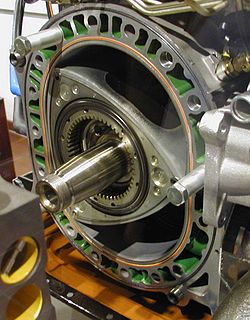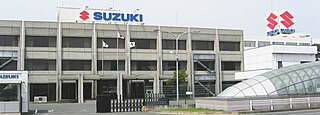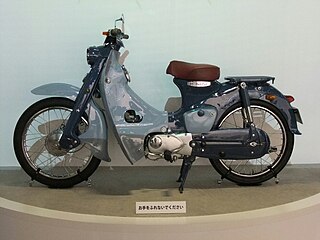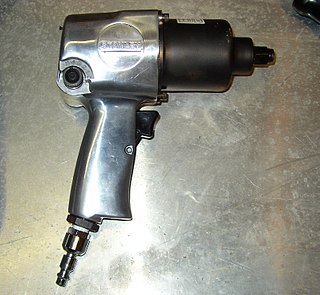
The Wankel engine is a type of internal combustion engine using an eccentric rotary design to convert pressure into rotating motion.

A two-strokeengine is a type of internal combustion engine that completes a power cycle with two strokes of the piston during one power cycle, this power cycle being completed in one revolution of the crankshaft. A four-stroke engine requires four strokes of the piston to complete a power cycle during two crankshaft revolutions. In a two-stroke engine, the end of the combustion stroke and the beginning of the compression stroke happen simultaneously, with the intake and exhaust functions occurring at the same time.

Suzuki Motor Corporation is a Japanese multinational corporation headquartered in Minami-ku, Hamamatsu, Japan. Suzuki manufactures automobiles, motorcycles, all-terrain vehicles (ATVs), outboard marine engines, wheelchairs and a variety of other small internal combustion engines. In 2016, Suzuki was the eleventh biggest automaker by production worldwide. Suzuki has over 45,000 employees and has 35 production facilities in 23 countries, and 133 distributors in 192 countries. The worldwide sales volume of automobiles is the world's tenth largest, while domestic sales volume is the third largest in the country.

Car tuning is the modification of a car to optimise it for a different set of performance requirements from those it was originally designed to meet. Most commonly this is higher engine performance and dynamic handling characteristics but cars may also be altered to provide better fuel economy, or smoother response. The goal when tuning is the improvement of a vehicle's overall performance in response to the user's needs. Often, tuning is done at the expense of emissions performance, component reliability and occupant comfort.

The Honda Super Cub or Honda Cub is a Honda underbone motorcycle with a four-stroke single-cylinder engine ranging in displacement from 49 to 124 cc.

The six main types of motorcycles are generally recognized as standard, cruiser, touring, sports, off-road, and dual-purpose. Sport touring is sometimes recognized as a seventh category or integrated with the touring category.

The Suzuki GSX-R750 is a sports motorcycle made by Suzuki. It was introduced at the Cologne Motorcycle Show in October 1984 as a motorcycle of the GSX-R series.

An impact wrench is a socket wrench power tool designed to deliver high torque output with minimal exertion by the user, by storing energy in a rotating mass, then delivering it suddenly to the output shaft. It was invented by Robert H. Pott of Evansville, Indiana.

The Suzuki GT750 was a water-cooled three-cylinder two-stroke motorcycle made by Suzuki from 1971 to 1977. It was the first Japanese motorcycle with a liquid-cooled engine. The Society of Automotive Engineers of Japan(in Japanese), includes the 1971 Suzuki GT750 as one of their 240 Landmarks of Japanese Automotive Technology.

An underbone is a type of motorcycle that uses structural tube framing with an overlay of plastic or non-structural body panels and contrasts with monocoque or unibody designs where pressed steel serves both as the vehicle's structure and bodywork. Outside Asia, the term underbone is commonly misunderstood to refer to any lightweight motorcycle that uses the construction type, known colloquially as step-throughs, mopeds or scooters.

In the automotive industry, alloy wheels are wheels that are made from an alloy of aluminium or magnesium. Alloys are mixtures of a metal and other elements. They generally provide greater strength over pure metals, which are usually much softer and more ductile. Alloys of aluminium or magnesium are typically lighter for the same strength, provide better heat conduction, and often produce improved cosmetic appearance over steel wheels. Although steel, the most common material used in wheel production, is an alloy of iron and carbon, the term "alloy wheel" is usually reserved for wheels made from nonferrous alloys.
The Honda Elite is a series of scooters manufactured by Honda since 1983. Honda currently makes the 108 cc (6.6 cu in) 2010 Elite.

The GT series is a series of two-stroke chain drive motorcycles manufactured and marketed by Suzuki for model years 1972-1977, with a range of engine capacities and cylinder counts. Certain markets received the GT380 until model year 1980.
Motorcycle accessories are features and accessories selected by a motorcycle owner to enhance safety, performance, or comfort, and may include anything from mobile electronics to sidecars and trailers. An accessory may be added at the factory by the original equipment manufacturer or purchased and installed by the owner post-sale as aftermarket goods.
The exoskeletal engine (ESE) is a concept in turbomachinery design. Current gas turbine engines have central rotating shafts and fan-discs and are constructed mostly from heavy metals. They require lubricated bearings and need extensive cooling for hot components. They are also subject to severe imbalance that could wipe out the whole rotor stage, are prone to high- and low-cycle fatigue, and subject to catastrophic failure due to disc bursts from high tensile loads, consequently requiring heavy containment devices. To address these limitations, the ESE concept turns the conventional configuration inside-out and utilizes a drum-type rotor design for the turbomachinery in which the rotor blades are attached to the inside of a rotating drum instead of radially outwards from a shaft and discs. Multiple drum rotors could be used in a multi-spool design.

A scooter is a motorcycle with an underbone or step-through frame and a platform for the rider's feet, emphasizing comfort and fuel economy. Elements of scooter design were present in some of the earliest motorcycles, and scooters have been made since at least 1914. Scooter development continued in Europe and the United States between the World Wars.

Industriewerke Ludwigsfelde is an automotive factory in Ludwigsfelde in Brandenburg, just south of Berlin in Germany. The factory is part of Daimler AG and since 1991 it has made Mercedes-Benz vans. It is also the producer of the Multicar line of automobiles.
Thin wall injection molding is a specialized form of conventional injection molding that focuses on mass-producing plastic parts that are thin and light so that material cost savings can be made and cycle times can be as short as possible. Shorter cycle times means higher productivity and lower costs per part.

The Vespa T5 was a 125cc, single cylinder, 2 stroke scooter which was manufactured in the 1985-1999 period by Piaggio.

The Daihatsu Mira e:S is a kei car manufactured by the Japanese automaker Daihatsu as the successor to the original Mira. It was previewed by the "e:S" concept car at the 2009 Tokyo Motor Show. The car was introduced to the Japanese market in September 2011. It was also sold by Toyota as the Toyota Pixis Epoch, which was released on 10 May 2012 and by Subaru as the Subaru Pleo Plus, which was released on 21 December 2012.
















